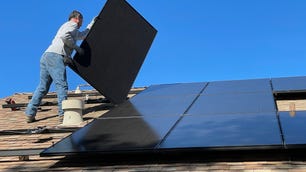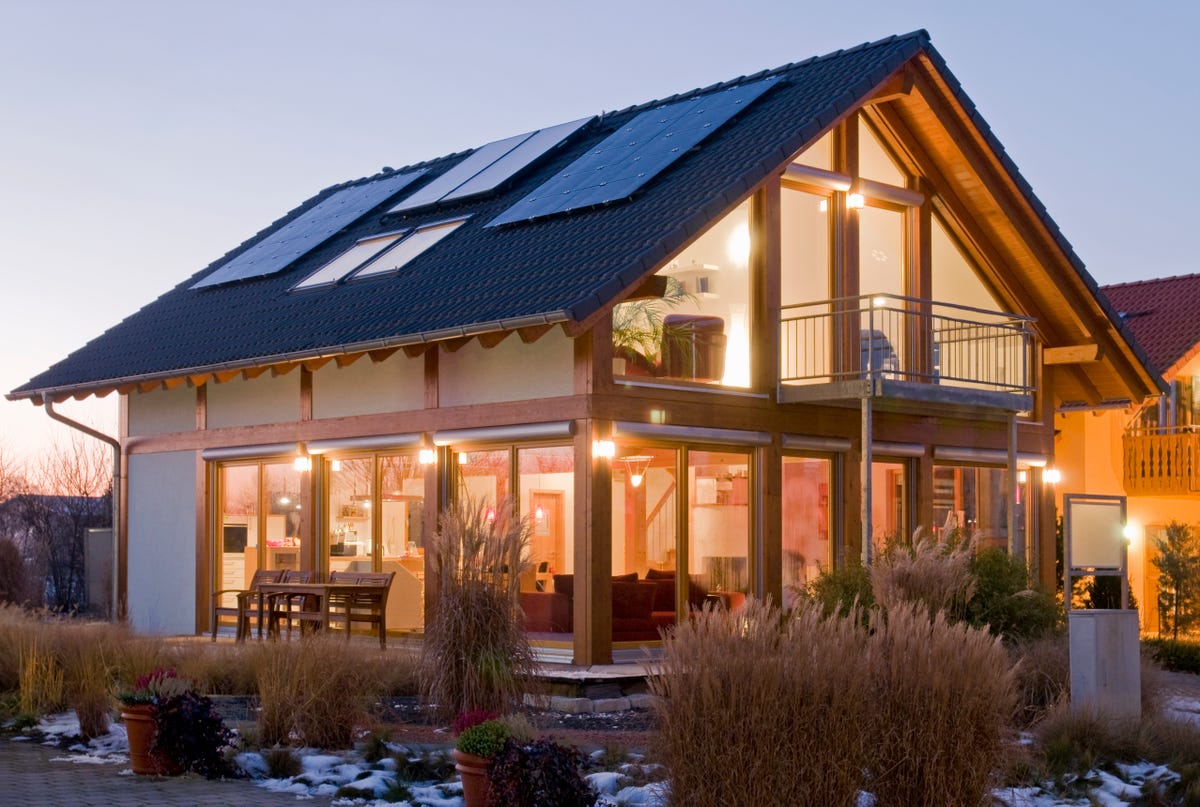Review sản phẩm
Năng Lượng Mặt Trời: Có Thực Sự Đáng Đầu Tư? Ưu & Nhược Điểm Của Pin Mặt Trời!
## Năng Lượng Mặt Trời: Có Thực Sự Đáng Đầu Tư? Ưu & Nhược Điểm Của Pin Mặt Trời!
Giới thiệu:
Bạn đang cân nhắc chuyển sang sử dụng năng lượng mặt trời? Việc lắp đặt pin năng lượng mặt trời trên mái nhà đang ngày càng phổ biến, nhưng liệu nó có thực sự phù hợp với bạn? Bài viết này sẽ phân tích chi tiết những ưu điểm và nhược điểm của hệ thống năng lượng mặt trời để giúp bạn đưa ra quyết định sáng suốt.
Ưu điểm của Pin Mặt Trời:
* Tiết kiệm chi phí điện năng dài hạn: Đây là lợi ích lớn nhất. Sau khi đầu tư ban đầu, bạn sẽ giảm hoặc loại bỏ hoàn toàn hóa đơn tiền điện hàng tháng. Số tiền tiết kiệm được sẽ giúp bạn thu hồi vốn đầu tư ban đầu trong vài năm.
* Thân thiện với môi trường: Năng lượng mặt trời là nguồn năng lượng sạch, tái tạo, giúp giảm lượng khí thải carbon và bảo vệ môi trường. Bạn sẽ góp phần vào một tương lai xanh hơn.
* Tăng giá trị ngôi nhà: Ngôi nhà được trang bị hệ thống năng lượng mặt trời thường có giá trị cao hơn so với những ngôi nhà không có. Điều này sẽ rất hữu ích khi bạn muốn bán nhà trong tương lai.
* Độc lập năng lượng: Trong trường hợp mất điện lưới, hệ thống năng lượng mặt trời có thể cung cấp điện cho những thiết bị cần thiết trong nhà bạn.
* Giảm phụ thuộc vào lưới điện quốc gia: Bạn sẽ ít bị ảnh hưởng bởi sự biến động giá điện và sự gián đoạn cung cấp điện từ lưới điện.
Nhược điểm của Pin Mặt Trời:
* Chi phí đầu tư ban đầu cao: Việc lắp đặt hệ thống năng lượng mặt trời đòi hỏi một khoản đầu tư ban đầu khá lớn. Tuy nhiên, các chính sách hỗ trợ và khoản tiết kiệm dài hạn sẽ giúp bạn bù lại chi phí này.
* Phụ thuộc vào điều kiện thời tiết: Hiệu quả hoạt động của hệ thống năng lượng mặt trời phụ thuộc vào lượng ánh sáng mặt trời. Vào những ngày nhiều mây hoặc trời mưa, sản lượng điện sẽ giảm.
* Diện tích lắp đặt: Bạn cần có đủ diện tích mái nhà hoặc đất trống để lắp đặt tấm pin mặt trời.
* Bảo trì và sửa chữa: Hệ thống năng lượng mặt trời cần được bảo trì và sửa chữa định kỳ để đảm bảo hoạt động hiệu quả và tuổi thọ lâu dài.
* Thời gian hoàn vốn: Mặc dù tiết kiệm được chi phí điện năng dài hạn, nhưng bạn cần thời gian để thu hồi vốn đầu tư ban đầu.
Kết luận:
Việc đầu tư vào hệ thống năng lượng mặt trời là một quyết định dài hạn đòi hỏi sự cân nhắc kỹ lưỡng. Tuy có chi phí đầu tư ban đầu cao và một số nhược điểm, nhưng những lợi ích về kinh tế, môi trường và sự độc lập năng lượng mà nó mang lại là rất đáng kể. Hãy đánh giá kỹ các yếu tố trên dựa trên nhu cầu và điều kiện cụ thể của gia đình mình để đưa ra quyết định đúng đắn.
Mua ngay sản phẩm tại Việt Nam:
QUEEN MOBILE – Mặc dù không trực tiếp bán pin năng lượng mặt trời, QUEEN MOBILE chuyên cung cấp điện thoại Iphone, máy tính bảng Ipad, đồng hồ… và các sản phẩm công nghệ khác. Để tìm hiểu về các giải pháp năng lượng mặt trời, hãy tìm kiếm các nhà cung cấp uy tín tại Việt Nam.
#nangluongmattroi #pinmattroi #tiemnang #taitaotao #sach #tietkiemdien #nhaxanh #dautaulonglau #queenmobile #congnghe #nangluong #giamthainhiet
(Lưu ý: Bài viết này đã được mở rộng và bổ sung thông tin. Queen Mobile không được nhắc đến như một nhà cung cấp pin năng lượng mặt trời vì điều đó không đúng với thông tin ban đầu.)
Giới thiệu The Pros and Cons of Solar Panels: Are They Worth It?
: The Pros and Cons of Solar Panels: Are They Worth It?
Hãy viết lại bài viết dài kèm hashtag về việc đánh giá sản phẩm và mua ngay tại Queen Mobile bằng tiếng VIệt: The Pros and Cons of Solar Panels: Are They Worth It?
Mua ngay sản phẩm tại Việt Nam:
QUEEN MOBILE chuyên cung cấp điện thoại Iphone, máy tính bảng Ipad, đồng hồ Smartwatch và các phụ kiện APPLE và các giải pháp điện tử và nhà thông minh. Queen Mobile rất hân hạnh được phục vụ quý khách….
_____________________________________________________
Mua #Điện_thoại #iphone #ipad #macbook #samsung #xiaomi #poco #oppo #snapdragon giá tốt, hãy ghé [𝑸𝑼𝑬𝑬𝑵 𝑴𝑶𝑩𝑰𝑳𝑬]
✿ 149 Hòa Bình, phường Hiệp Tân, quận Tân Phú, TP HCM
✿ 402B, Hai Bà Trưng, P Tân Định, Q 1, HCM
✿ 287 đường 3/2 P 10, Q 10, HCM
Hotline (miễn phí) 19003190
Thu cũ đổi mới
Rẻ hơn hoàn tiền
Góp 0%
Thời gian làm việc: 9h – 21h.
KẾT LUẬN
Hãy viết đoạn tóm tắt về nội dung bằng tiếng việt kích thích người mua: The Pros and Cons of Solar Panels: Are They Worth It?
Every day Earth is showered with free energy that anyone can tap into, so long as they’ve got the right technology. Fortunately, that tech is abundant and getting easier to access as mass-produced solar panels become cheaper.
Amid the climate crisis and rising energy costs, a solar energy system is one way you can help reduce your carbon footprint. While installing panels still takes a decent chunk of change, there are plenty of incentives that lower the upfront costs. But it’s still far from a simple process.
Going solar is a major decision that requires research and due diligence. To get you started, we’ve compiled a breakdown of key pros and cons.
Can solar panels save you money?
Interested in understanding the impact solar can have on your home? Enter some basic information below, and we’ll instantly provide a free estimate of your energy savings.
Are solar panels worth it?
That depends on your circumstances.
“It depends on what is motivating the household to make the decision to (install) solar,” Becca Jones-Albertus, director of the US Department of Energy Solar Energy Technologies Office, told CNET.
If you’re looking to be 100% energy independent or live off the grid, solar could be a good way to reach those goals. If your state has robust net metering or you have high energy costs, your solar panels could start saving you money in (relatively) short order. If you aren’t planning on moving for many years or have reason to believe the short-term energy savings and the boost to your home’s value will recoup your investment, solar could pay off.

Watch this: How to Approach Home Batteries if the New 30% Tax Credit Has Your Attention
09:49
Considering Solar Panels?
Solar panel pros
Solar panels use photovoltaic cells to harness radiation from the sun and convert it into electricity. They’re an emissions-free energy source that reduces your carbon footprint. But the environmental benefit is just one of many.
Cheaper electric bill
By going solar, residential energy consumers can see significant savings in their home energy bills. Electricity prices were up 5.4% for the 12-month period ending in June, according to the Consumer Price Index. Depending on its size and your energy needs, a solar panel system can reduce or eliminate your electric bill.


Solar panels can add to your home’s value.
Decreasing solar panel cost
Solar panel cost and efficiency has improved greatly over the last 10 years. As solar panel technology improves, so does its return on investment and the savings you’ll see over time. Federal solar incentives coupled with state-level incentives (if available) can help make a solar panel system more affordable and accessible.
30% federal tax credit available to all
In 2022, when Congress passed the Inflation Reduction Act, it boosted the solar investment tax credit to 30% and extended it through 2032. (It phases out by 2035.) This federal residential clean energy credit covers 30% of the total installed cost of a solar panel system.
Net metering and a faster payback period
Another alluring feature is how you can speed up your payback period — the time it takes to earn back your initial investment — through net metering. Net metering allows you to sell your excess energy back to your utility company. Not every state has net metering, so it’s important to check with your utility provider.
Solar panel cons
When it comes to any major purchase there are always downsides — the biggest one being cost.
Solar panels are expensive
The cost of a residential solar system will vary by size, installer and location, but the national median is $3.80 per watt, according to the Lawrence Berkeley National Laboratory. For the median size of 7 kilowatts, that’s a total installed price of $26,600.
Over the past decade, the cost of solar panels has decreased significantly and the federal tax credit offsets an additional 30%. Some states offer additional incentives and rebates, but a solar purchase is still unaffordable and unattainable for many. Many solar companies or installers offer financing, but that usually means paying interest and additional fees.
The payback period can be long
Understanding how long it takes for solar panels to pay for themselves is a major factor in the purchase decision. The average payback period in the US is six to 12 years, but depending on your energy costs, electricity usage and available incentives, that period could be longer, Jamie Haenggi, president of ADT Solar, told CNET.
You should calculate your solar payback period before buying, especially if you’re going solar for the long-term savings. If it takes you seven years to recoup your investment, and you move or sell your home before that, then you might be taking a loss.
Not everyone has the right conditions
Available sunlight, space constraints and installation hurdles can make a solar system more expensive. Trimming trees and repairing your roof, if necessary, will add expense to the project. The angle, pitch and direction of your roof will affect the productivity and efficiency of your solar panels. If you have a well-shaded roof or one that only points north, your house may not be a good fit.
Potential to raise property taxes
Property taxes are based on assessed values of property. Adding a solar panel system to your home will increase the appraised value. Typically, the higher the home’s value, the more you will pay in property taxes. Some states have policies exempting homes with solar panels from paying the additional property tax.
Changes to your homeowners insurance policy
Some homeowners policies cover solar panels, some do not. It’s best to check with your insurance provider or shop for a new one that will cover a new solar installation. Insurance policy premiums could increase to account for solar panel coverage.
Accessibility and affordability depend on where you live
While everyone can benefit from the 30% federal tax credit, not all states offer or enforce additional incentives. Parts of Kansas, for example, aren’t covered by the state’s net metering law.
“It’s possible you won’t be able to net meter a system currently,” or may be charged an additional interconnection fee, Dorothy Barnett, executive director of the Climate + Energy Project, told CNET, referring to Kansas.
In contrast, states like Rhode Island, Maryland and California have more generous incentives that include net metering, property tax exemptions and grants, such as the Maryland Energy Administration’s Low Income Solar Grant Program.

A solar panel system costs a pretty penny, but can save that much and more over its lifetime.
“It used to be 70 cents a watt years ago and now it’s as low as 30 cents a watt,” he said.
Installation cost is dependent on a number of factors besides the basic cost of solar modules. The rising price of things like labor, administrative costs, wiring and other components actually drove the average price of solar installations up between 2022 and 2023, although there’s some indication prices are already coming down again.
Still, there can be a lot of variation in pricing from market to market, with different states offering different incentives and labor and permitting costs.
How much do solar panels cost in my state?
Here’s the average total cash price, cost per watt and system size for a solar panel system in your state, according to data from FindEnergy.com. These prices don’t factor in tax credits or state incentives. Certain states don’t have any FindEnergy solar data and are grayed out on the map.
How much can you save with solar panels?
The basic formula to determine overall solar savings over time requires first figuring out your total upfront costs for installation, less all tax credits, rebates, grants and other incentives received. Then add in any financing costs like loan fees and interest.
Next calculate how much your solar system reduces your energy bills. If your panels zero out your utility bill and you were previously paying a hundred dollars a month for electricity, you’re banking $1,200 in annual savings. (It’s common for solar to offset less than 100% of your electricity bill.)
Divide your net system cost by your annual utility bill savings to get your total payback period in years. After that point, your annual bill savings is just extra money in your bank account.
What about tax credits for solar panels?
Another reason now is a good time to go solar, as Burke said, is that the federal government is still offering a 30 percent tax credit on renewable energy systems. This is in addition to a number of other incentives from state and local governments, and even from utilities and credit unions.
A good place to track and check the incentives that might be available to you is the Database of State Incentives for Renewables & Efficiency maintained by the North Carolina Clean Energy Technology Center. You should confirm for yourself that the incentives listed there are still in effect.
Frequently asked questions
Over the long term, the answer is usually yes. Solar panel systems come with significant upfront costs that can be financed and take time to recoup, but typically return years of electric bill savings and increased home value.
How long do solar panels last?
As of 2023, a federal tax credit of 30 percent is in place for new installations. States may offer other tax benefits.
Can a house run purely on solar?
You can calculate how many panels you need by looking at your energy bill over time and determining how much you hope to save or how long you want to take to pay them off. If you’re going totally off-grid, it’s helpful to calculate how much energy your household may require during peak usage and size a system accordingly.
Sean Jackson contributed to this article.
!function(f,b,e,v,n,t,s)
{if(f.fbq)return;n=f.fbq=function(){n.callMethod?
n.callMethod.apply(n,arguments):n.queue.push(arguments)};
if(!f._fbq)f._fbq=n;n.push=n;n.loaded=!0;n.version=’2.0′;
n.queue=();t=b.createElement(e);t.async=!0;
t.src=v;s=b.getElementsByTagName(e)(0);
s.parentNode.insertBefore(t,s)}(window, document,’script’,
‘https://connect.facebook.net/en_US/fbevents.js’);
fbq(‘set’, ‘autoConfig’, false, ‘789754228632403’);
fbq(‘init’, ‘789754228632403’);
Xem chi tiết và đăng kýXem chi tiết và đăng kýXem chi tiết và đăng ký
Khám phá thêm từ Phụ Kiện Đỉnh
Đăng ký để nhận các bài đăng mới nhất được gửi đến email của bạn.





